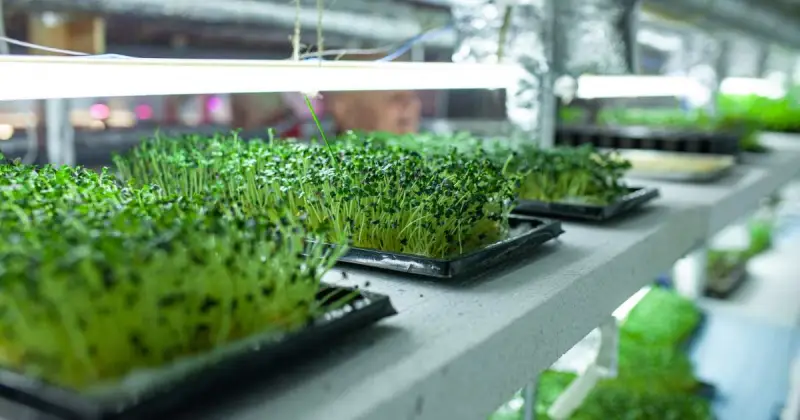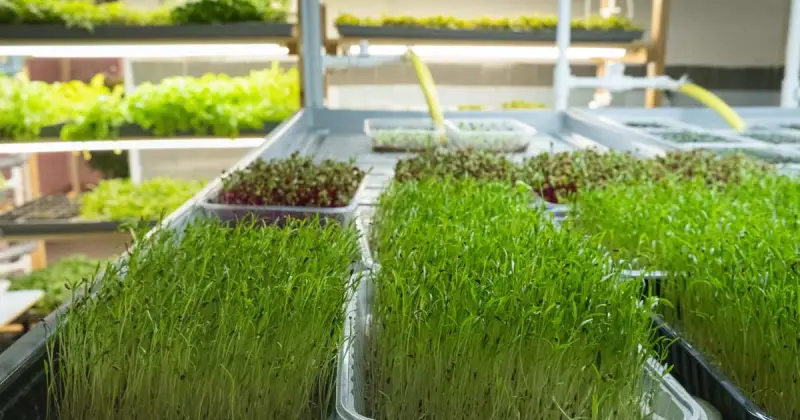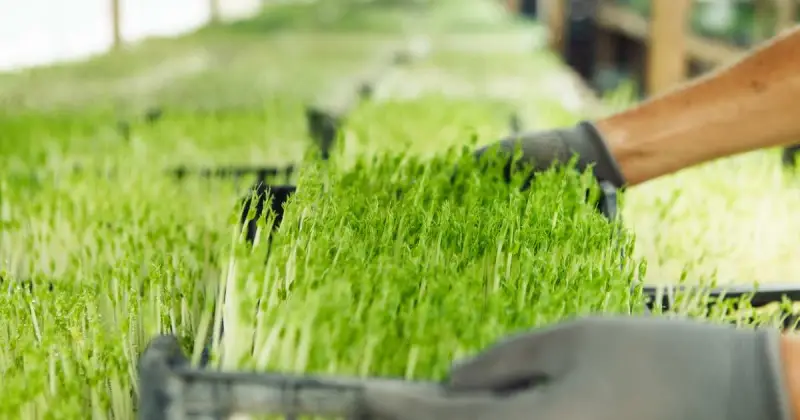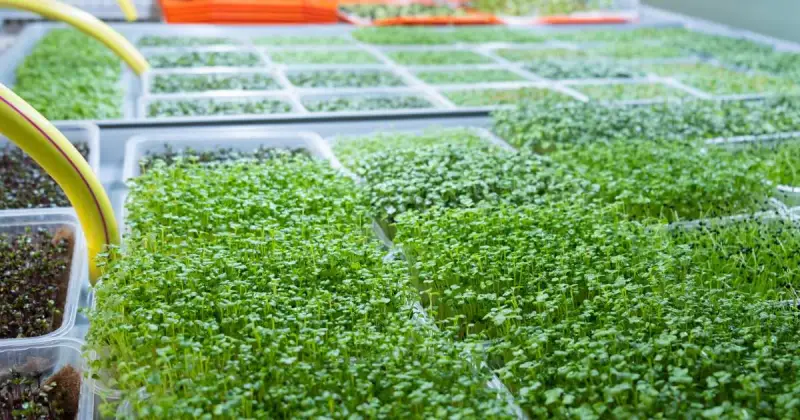Microgreens are a versatile and highly profitable crop you can quickly grow and sell. If you want to start an excellent local business, growing microgreens is a great option. Not only can you grow microgreens and create a profitable business due to high demand, but the startup costs are relatively low, making it accessible for anyone interested in entering the industry.
Growing microgreens is more cost-effective compared to other garden crops. A budget of $250 to $500 is typically sufficient. And for you to start a microgreens business, you generally need capital of less than $1,000.

In this article, I will explain the costs of growing microgreens and how much you need to start your microgreens business today. I will also offer a comprehensive guide on understanding microgreens while providing basics on operating and marketing your business.
From gaining knowledge to reaping profits, you’ll discover a detailed guide to prosper in this flourishing industry. So, without further ado, let’s transform these petite greens into a substantial opportunity!
Humble Highlights
- Stop wondering if starting a microgreen business can be successful, and discover these 5 reasons why getting into this budding industry now might be right for you so you can serve your community and have fun!
- Save money by discovering these ridiculously easy microgreen tools so you can get started quickly, AND use our resourceful, done-for-you chart on which 10 micros can be the most profitable when just starting.
- Save time with these 3 vital steps on how to market and sell your greens so you can research your local area first to see if starting a business can be right for you.
Why Start Your Microgreens Business?
Growing microgreens for profit can be an exciting and rewarding venture for several reasons, including the following:

Potential For High Profit Margins
Microgreens are considered uniquely special by many, and people are willing to pay extra due to their taste, visual appeal, and nutrition. These are just three primary reasons you can make more money compared to growing some other types of plants. 1
Therefore, when selling microgreens, you can typically charge higher prices and profit more for each tray or batch you grow and sell.
High Demand For Microgreens
Microgreens are gaining popularity due to their nutritional value and versatility. They are rich in vitamins (such as vitamins C, K, and A), minerals (including iron, calcium, magnesium, and potassium), and antioxidants. For example, broccoli microgreens are high in vitamin C and sulforaphane, which can be excellent for overall health.
Chefs, restaurants, and health-conscious individuals increasingly incorporate microgreens into their dishes. This high demand ensures a consistent market for your microgreens.

Quick Growth & Turnaround
Microgreens grow fast. Unlike many other plants that take months to mature in a traditional backyard garden setting, micros are usually ready to be picked and sold in just a few short weeks (often around 1-2 weeks).
This quick turnaround is one of the advantages that make microgreens an attractive choice for many people interested in starting a business compared to longer-term farming.
Low Startup Costs
Compared to other agricultural ventures, starting your baby greens business requires minimal investment. They thrive in small spaces, from spare rooms to shelves, urban balconies to greenhouses, making land requirements a non-factor.

Additionally, essential gardening tools replace heavy machinery, reducing equipment costs. Infrastructure needs are also minimal—shelving, trays, and grow lights suffice, avoiding pricey barns or irrigation systems. 2
Moreover, microgreens’ quick growth means less physical labor and less water use. They’re also less susceptible to pests and diseases, saving on treatments and pesticides.
Scalable Business Model
Growing and selling microgreens is a very scalable business model. Scalability refers to increasing the microgreens produced and sold without encountering significant obstacles. This could involve expanding the growing area, increasing the varieties grown, or reaching a more extensive customer base.
Basic Things You Need To Start Growing Microgreens
There are different varieties of microgreens, such as basil, radish, cilantro, kale, and sunflower, that you can start growing in your home or garden. Each kind of microgreen may have its differences in the way it should be developed and harvested, but they all go through the same process.

- Microgreen Seeds: Choose high-quality seeds like sunflower, radish, pea, broccoli, or mustard.
- Growing Medium: Use well-draining and sterile potting mix, soilless growing medium, or coconut coir.
- Containers or Trays: Use shallow containers or trays (standard 10×20 size) with drainage holes.
- Light Source: Provide adequate natural sunlight or invest in grow lights for indoor growth.
- Watering Tools: Have a spray bottle or watering can for gentle moisture control.
Given that you know what type of microgreens you are cultivating and understand their growth time, you can now look to drafting your business plan template, which can help organize a strategy to help sell your greens in the market. 3
Take a few minutes and watch the detailed video below, which explains the pros and cons of starting and operating a microgreen business. Remember, it’s always a good idea to gather as much information about any operation before beginning. So do yourself a solid, take a look, and get informed!
How Much Money To Fund Your Business? Is It Profitable?
You can begin with an initial budget of under $100, but I suggest starting with approximately $500 and planting ten trays. This approach allows you to quickly identify what works and what doesn’t, enabling you to focus on the most successful strategies for your little green business.
Profitable Microgreens To Grow
Before anything else, you need to know which varieties of microgreens are sellable in the industry. These microgreens have a shorter growth time, so you can harvest them quickly and grow multiple batches in a month. 4
Below is a table of the most profitable kinds of microgreens.
| Microgreen Variety | Flavor Profile | Growth Time (Days) | Popular Uses (Benefits) |
|---|---|---|---|
| Radish | Peppery | 7-12 | Salads, sandwiches, garnishes |
| Sunflower | Nutty, slightly sweet | 7-12 | Salads, sandwiches, wraps |
| Pea | Mild, fresh | 7-14 | Salads, garnishes, stir-fries |
| Arugula | Peppery, nutty | 7-12 | Salads, pizzas, sandwiches |
| Broccoli | Mild, slightly bitter | 7-12 | Salads, sandwiches, soups |
| Cilantro | Citrusy, herbal | 7-12 | Salsas, Mexican dishes, garnishes |
| Cabbage | Mild, slightly sweet | 7-14 | Salads, coleslaw, sandwiches |
| Amaranth | Nutty, earthy | 7-12 | Salads, stir-fries, grain bowls |
| Kale | Mild, slightly bitter | 7-14 | Salads, smoothies, sandwiches |
| Chia | Nutty, earthy | 7-14 | Smoothies, puddings, garnishes |
It’s worth noting that profitability can vary based on factors like market demand, local preferences, and your ability to grow and market these microgreens effectively. It’s best to research your local market and consider customer preferences when deciding which varieties to cultivate for your microgreens business.
Summary Costs To Launching A Successful Microgreens Business
When purchasing microgreens at the farmer’s market, grocery stores, or online, it’s crucial to identify the most cost-effective options, especially when beginning. Remember, starting small is wise, as it’s best to invest only a little money on your initial attempt until you become more seasoned. 5

Below are the essential cost categories to consider when starting a microgreens venture.
- Seeds: Typically ranging from $5 to $20 per ounce, depending on the variety.
- Growing Medium: Usually priced between $10 to $30 per bag, depending on brand and quantity.
- Containers or Trays: Typically costing around $1 to $3 per tray, with and without drainage holes.
- Lighting: For indoor growth, fluorescent or LED grow lights can range from $20 to $100 or more, depending on size and type.
- Business Permit/License fees: Normally range between $15-20 to $300, or more, depending on the state you are in. Always consult federal, state, and local laws when starting your enterprise.
- Miscellaneous: Miscellaneous expenses for items like labels, packaging, and record-keeping materials, totaling around $10 to $20 initially.

Start Up Computation For A Competitive Selling Price
The selling price of microgreens varies depending on factors such as location, competition, and quality. You can start with radish seeds, peas, or sunflowers, as these varieties are among the less expensive options, typically ranging from $1 to $5 per ounce.
To determine your selling price, you must conduct a thorough cost analysis. I will teach you how to calculate your production costs, including seeds, growing medium, utilities, labor, and packaging. With the costing details I provided above, you can use it as a guide to starting a microgreens venture. 6
Business Expense Illustration: 1020 large tray (10×20 inches)
Expenses/costs:
- Seeds – $60 ($3 per ounce x 2 ounces x 10 trays)
- Growing Medium – $100 ($10 x 1 bag x 10 trays)
- 10 Containers or Trays – $30 ($3 per tray)
- Lighting (LED) – $150 ($30 x 5) – 2 trays per 1 led light
- Business Permit/License fees – $30
- Miscellaneous – $50 (labels, packaging, marketing strategies, record books, subscription fees)
Total Cost – $420 for 10 trays or $42 per tray

If you aim to earn more than half the cost, your profit margin should equal 50% of the revenue. To determine the selling price per tray, you can calculate it by adding the desired profit margin to the total cost.
- Start with the total cost per tray: $42
- Calculate the desired profit: $42 x 50% = $21
- Add the profit to the total cost: $42 (total cost) + $21 (profit) = $63 per tray
Summary:
- Total Selling Price per Tray: $63
- Net Profit per Tray: $21
- Net Profit per 10 Trays: $210
After compiling a list of expenses and costs you’ll incur in starting your business, from purchasing the seeds to registering your business locally, you can draft your business plan.
Like anything, starting small and building from there is a sound and age-old practice that can later bring big rewards. However, with the right market and sound research, a microgreens business can be successful. Check out the video below, where several mico growers share their success, challenges, planting schedules, future plans, and so much more!
Microgreen Business Idea: How To Sell Microgreens
Microgreens Business Plan
A business plan is a unique document that you create to help you prepare for your business. This means you start drafting the type of business you want and decide on the perfect time to start. So, is a business plan also important in starting your business in the world of microgreens?
A well-crafted business plan demonstrates your commitment to your baby greens business and increases your chances of securing funding or investments. It also helps you identify potential challenges that may arise and develop strategies to overcome them. 7

A comprehensive business plan includes an executive summary, business description, market analysis, marketing strategies, financial projections, and an operational plan. Take the time to develop each section to ensure your business plan is thorough and effective for the best success.
Identify Your Target Market
Starting a microgreens business requires identifying your target market. Ask yourself, ‘Who am I selling to? Individuals, restaurants, local markets, or grocery stores?’ Basically, ‘Who wants to buy my microgreens?’
Start by studying your competitors—whether they’re in the farmer’s market, local grocery stores, or online. It’s best to research who else is selling microgreens in your area, along with the varieties they offer.

Let’s create a hypothetical situation to illustrate how you might research your competition in a specific area. For example, you’re considering starting a microgreens business in a medium-sized city in the United States, and you want to research your competition in the local area to understand what varieties they offer.
Here’s what you might find:
- Farmers’ Markets: Two existing vendors at the city’s popular Saturday farmers’ market sell microgreens. Vendor A primarily offers sunflower and pea shoots, while Vendor B specializes in radish and broccoli microgreens. Both vendors have loyal customers and have been operating for several years.
- Online Sellers: A quick online search reveals several online sellers based in your state who offer various microgreens, including unique options like amaranth, beet, and basil microgreens. Some of these sellers also offer home delivery services.
- Local Grocery Stores: Your visit to the city’s two largest grocery stores reveals that they stock a limited selection of microgreens, primarily consisting of the more common varieties like sunflower, radish, and broccoli. The grocery store brands are sourced from regional suppliers.
In this scenario, you’ve identified existing competitors in your area, their specialties, and the varieties they offer. This information can be valuable in helping you decide which microgreen varieties to grow and how to differentiate your business to meet local demand and stand out in the market.

Marketing Strategies
Your entire business will depend on the effectiveness of your marketing strategies. A significant portion of your marketing strategy should be devoted to capturing the attention of your target market by addressing their needs and desires.
This approach is the initial step in getting your microgreens business up and running. You can start by promoting your product extensively on social media and establishing links to your online stores. 8
Here’s a quick example of an online platform marketing strategy:
- Develop a user-friendly website or e-commerce platform where customers can easily browse and purchase your microgreens.
- Offer comprehensive product information, including available varieties, pricing, and delivery options.
- Enhance your website’s visibility by optimizing it for search engines (SEO).
- Explore e-commerce platforms like Shopify, WooCommerce, or Etsy to efficiently set up your online store.
Highlight the benefits of each type of microgreens you’re selling from your microgreens farm on your social media and online shops. Additionally, consider launching a website that showcases your microgreens with high-quality images and detailed descriptions.
To encourage customers to purchase directly from your online shops, offer an easy online ordering system with secure payment options. This way, you will make it convenient for your customers to buy your microgreens.

Conclusion
Now that we have discussed and underscored the fundamental principles and considerations for a successful microgreens venture, from understanding the unique advantages of microgreens to the critical steps involved in their cultivation and business operation, the success of your business is now in your hands.
Again, choosing suitable varieties, ensuring optimal growing conditions, and planning your business scale are vital components in harnessing the potential of microgreens. This rapidly growing market can offer opportunities for both experienced growers and newcomers alike.
By embracing innovation, maintaining quality, and staying attuned to market trends, you can not only cultivate healthy and flavorful microgreens but also build a thriving and profitable microgreens business.
As you start to create a business out of your microgreens, remember that dedication, continuous learning, and adaptability will be your allies in achieving success in the world of microgreens.
Have you already started a micro business? We’d love to know the successes and challenges of your story. Drop us a comment below and share your experience with other growers!
SOURCES
- ScienceDirect – Microgreen: A Tiny Plant With Superfood Potential
- North Carolina Department Of Agriculture & Consumer Services – Small-Farm Workshop Inspired Start-Up Microgreens Venture
- Entrepreneur, India – [Start-It-Up] How To Start Microgreen Farming Business?
- WTOL11 – Microgreen Are A Growing Business In Fremont
- Siouxfalls.Business – New Small Farmer Leads Growing Microgreens Business
- Medium.com – Estimates For Part-Time Microgreens Production In A Greenhouse
- DotComMagazine.com – Microgreens Business – Top Ten Things You Need To Know
- CBSnew.com – Bronx Farm Grows Fresh Microgreens For Local Restaurants And Businesses, Keeping Food In Community







